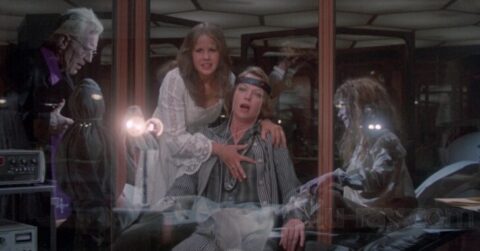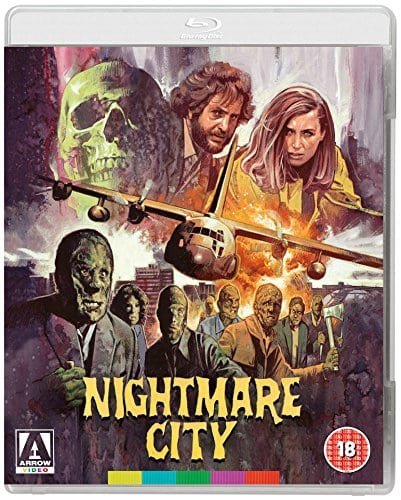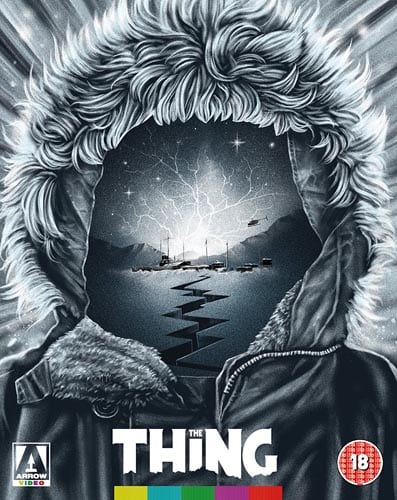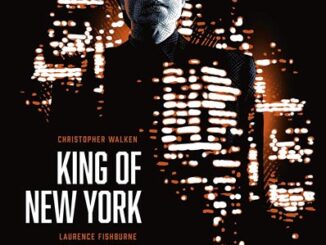Exorcist 2: The Heretic (1977)
Directed by: John Boorman
Written by: John Boorman, Rospo Pallenberg, William Goodhart
Starring: Linda Blair, Louise Fletcher, Max von Sydow, Richard Burton
USA
AVAILABLE ON BLU-RAY: 7th October, from ARROW VIDEO
RUNNING TIME: 117 mins / 106 mins
Reviewed by: Dr Lenera

It’s been four years since the exorcism that saved the life of Regan MacNeil and caused the deaths of Father Lankester Merrin and Father Damien Karras, the priests who helped her. Regan, although now seemingly normal and staying with her guardian Sharon Spencer in New York City, continues to be monitored at a psychiatric institute by Dr. Gene Tuskin who believes that her memories are repressed. She’s invented a device that can hypnotise two people and link their minds together. Meanwhile, Father Philip Lamont – his own faith shaken by a failed exorcism – is ordered by the Vatican to investigate the death of Merrin, who faces posthumous charges of heresy for his controversial writings. Lamont finds Regan while she’s using the mind device with Tuskin and sees that Pazuzu still lurks within her. Regan then starts having dreams of flying in Africa and Philip sets off for Ethiopia to find out more….

Willian Friedkin, director of The Exorcist, told a story that was recalled to him by a Warner Bros. executive. Studio heads came to the sneak preview of Exorcist 2 in a limousine, and told the driver to go and get some fast food. They entered the auditorium, and ten minutes into the film, an audience member stood up, glanced into the crowd, and proclaimed, “The people who made this piece of shit are in this room”! 10 or 11 other audience members gathered to find the executives, who rushed out of the cinema. Because there was no car with which to make their escape, they were chased down the street. I’m sure this story is true. The first sequel to the 1973 instant classic was rejected and mocked by critics and audiences alike, and is still widely considered to be one of the most terrible sequels of all time. When I first saw it at around 16, I’d read of its supposed badness in a book called “The Golden Turkey Awards” which claimed that it was the second worst film ever made. I was looking forward to laughing at the video, but I was surprised to find that, not only was it not nearly as bad as writer Michael Medved had made out, it was also, in a lot of places, rather good. It also reminded me of some of the Dennis Wheatley’s novels I’d recently been reading, which was certainly a good thing. Now I’m certainly not going to make a claim for it as an misunderstood masterpiece, because it’s at times a bit muddled. Hiring a director who hated the first film, calling it “repulsive”, was certainly a bizarre decision. It’s peculiarly lacking in the intense horror that made the original such a sensation, yet in my opinion still deserves some admiration for bravely trying to be different, going down different pathways, and, if you imagine a version that loses some of the perhaps too many references to The Exorcist, it stands on its own as a rather strange, metaphysical supernatural thriller.
Neither writer William Peter Blatty nor director William Friedkin wanted to do a sequel. Warners thought of doing a really low budget film about a priest interviewing people concerned with the exorcism, cue flashbacks to unused footage. This was thrown away when playwright William Goodhart wrote a screenplay which made use of many of the ideas of Jesuit archaeologist Pierre Tielhard de Chardin. The battle between good and evil would now centre on human consciousness, something that could be brought together as one through technology. Lee J. Cobb’s Lt. Kinnermann was to be the lead character, but Cobb died from a heart attack the day he signed on. Then it was to be William O’Malley’s Father Joseph Dyer, but the actor was unavailable so the character became Father Philip Lamont, who was to be played by Jon Voight until he left when “differences about the role could not be resolved”. Kitty Winn signed on to reprise the role of Sharon Spencer after Ellen Burstyn flatly refused to return as Chris MacNeil. Boorman asked Goodhart to do a rewrite using ideas from his usual collaborator Rospo Pallenberg; Goodhart refused so Boorman rewrote it himself with Pallenberg, rewrites still taking place during filming. Linda Blair, who refused to don her old makeup, frequently turned up late while Richard Burton often came back from lunch drunk so his major scenes were shot in the morning. Boorman wanted to shoot largely on location including Ethiopia and The Vatican, but most scenes were filmed at the Warners backlot except for some in New York and New Jersey. After only two days, Warners executives insisted that cinemas cut out the ending which people hated. Boorman then did a full re-edit, losing eight minutes; for international distribution three mins more were cut. It did actually make money.
The wailing during the opening titles hardly is irritating, then we’re somewhere in South America, and a young woman is seemingly possessed by a demon, though she also claims to be able to heal the sick. Father Lamont tries to exorcise her, equipped with a book in which he has a picture of Father Merrin whom he clearly calls upon to help “in the valley of the shadow of death”, but the people restraining the woman eventually fail and she bursts free to knock over lit candles, setting both the place and herself on fire. Lamont is then assigned by the Vatican to investigate the death of Merrin, whose writings caused him to be labeled a Satanist by some because of his interest in evil, not something that the Church wants as it’s trying to modernise and doesn’t want to acknowledge that Satan exists. Lamont doesn’t think he’s worthy, but sees evil everywhere himself so sets off. His first step is to find Regan, who resides at a school for special children which truly deserves mention for Richard Macdonald’s bizarre set design, with every kid living in a glass honeycomb and able to see each other – but then this is also a film where a rooftop is full of mirrors and a balcony railing has such huge gaps that people would easily be able to fall through them. Regan tells her boss Tuskin that she only remembers “being very sick and having nightmares”, but Tuskin has the “hypnosis synchroniser” which will allow her to see Regan’s dreams because it synchronises brainwaves[!]. Lamont shows up, stating that they’re up against “evil” rather than “mental illness”. The machine takes both women to Regan’s old room but Lamont has to stop Tuskin’s heart from defibrillating, which he’s somehow able to do, Regan then draws a picture of Lamont with fire behind him, which somehow [there are a lot of “somehows” in this movie] leads Lamont to find a fire in the building.

Regan begins to sleepwalk and almost falls off the top of the building while imagining she’s back in the past in Ethiopia witnessing a boy called Kokumo fighting off a plague of locusts while pretending to wield a lasso [!]. After a tour by Sharon of the Georgetown house where the exorcism took place, an eerie but perhaps overly prolonged scene, Lamont returns to be coupled with Regan by the synchroniser, cue for an amazing sequence as he’s spirited to the past by Pazuzu, the name of the demon which is actually of Babylonian origin, to observe Merrin [Max Von Sydow looking his own age rather than like an old man] exorcising Kokumo. The camera assumes Lamont’s point of view as it takes us on a journey over wildlife and towns to a mountain containing a rock church, and the feeling is genuinely mystical. Learning that the boy developed special powers to fight Pazuzu, who appears as a swarm of locusts, Lamont journeys properly to Africa to seek help from the adult Kokumo, who may just have the answers that Lamont needs, though few viewers would have prepared themselves for the things that he says, especially in 1977 when the recut version omitted Lamont earlier telling Regan about de Chardin and his World Mind theory. Lamont also believes it, that mankind can progress to an ‘overmind,’ a shared soul free of sin, but unfortunately there’s also the corruption of its opposite, the ego, a state of separation from consciousness, an evil imitation, though there are genetically altered ‘good locusts’ to combat the ‘bad locusts.’ Regan and other possessed young girls are really ‘good locusts’ because they have the power to heal, but have been possessed because Satan dispatched Pazuzu to wipe them out.
Um. Yeah. All this weird stuff was obviously both a shock and a turn-off after the powerful, direct simplicity offered in 1974, based primarily on faith, something that most viewers can get their head around even if they’re not Christian. It’s even a bit contradictory, We’re still presented with the idea of the Catholic Church fighting to save mankind’s soul, but, instead of a priest who rediscovers his faith, we have one who seems to abandon his faith and become immersed in a strange mix of voodoo religion and bonkers science. While the film’s subtitle doesn’t seem to refer to anything in it, one wonders if Boorman and Pallenberg suggest that Lamont is ‘the heretic’, even though one can also ponder on how daft it is that the story sends its hero to Africa and has him scaling mountains, climbing down gorges and walking on spikes, only to be told that Good and Evil are fighting inside Regan, something he could have probably worked out for himself if he’d stayed put – but then we wouldn’t have had the film’s depiction of Ethiopia as an almost mythical place of lost cities, mystical medicine men, lots of locusts, and a perpetual orange sky. Instead of the first movie’s almost documentary approach we have a dreamlike feel. The weird psychiatric centre allows Boorman and his cinematographer William A. Fraker to play lots of eerie games with characters appearing in reflection, characters seemingly appearing ‘inside’ others and characters never seeming to be alone – there’s almost always someone that can be seen through a window or mirror in the background. At one point Regan, Gene and Philip are in the middle of the frame, a flashback shot of Merrin and Regan appears around them and the possessed Regan in the old shot appears to touch Gene. These and other scenes make much use of the ancient but effective ‘ghost glass technique’, where the camera shoots something behind glass and something else is reflected in it at the same time.
Horror is largely lacking, Boorman generally avoiding blood [even though some of his other films don’t at all stint on the stuff], profanity and violence, not to mention a feeling of fear; he never seems to be even trying to frighten. Regan’s increasing evil power towards is economically shown, but the climax, set in Regan’s old house, is a little lame, and then there’s iffy dialogue like “When the wings have brushed you, is there no hope when the wings have brushed you?”, “No, when the wings have brushed you, you’re mine”. Pallenberg’s dialogue for other Boorman movies was sometimes like this, but worked when coming out of the mouth of say, Nicol Williamson’s eccentric Merlin. Here, it just usually seems funny, though Exorcist 2 doesn’t really show an incompetent filmmaker. This is a guy who made two genuinely great movies; Deliverance and Excalibur – and some really good ones. He knows what he’s doing. Just look at the many lengthy single shots which take in so much. So I can only ascertain that the often disjointed editing, with scenes suddenly ending, seeming to cut in half way through, really long scenes alternate with ten second ones etc., was a stylistic choice, rather than carelessness, though of course one questions whether Exorcist 2 was the right vehicle for such experimentation. You have to admire Boorman for his gall, even if you still don’t like what he created here, and also his attention to detail; just look at the number of shots where people have a light, usually flashing, by their head. As he often was – especially in the second half of his career – Burton is obviously pissed during many of his scenes, at times really looking glazed, and rarely coming across as being particularly committed, rarely showing much emotion As for Blair, she’s okay generally and good occasionally; look at the genuinely touching scene where Regan makes an autistic girl speak.

Composer Ennio Morricone wrote some highly evocative material here, employing some innovative and downright scary sounds and instrument combinations, often with an element of African tribal music, as well as penning one of his trademark lovely melodies with the wordless voicing of Edda Dal ‘Orso. As he often did due to being so busy, he wrote a number of pieces inspired by a viewing of the film which were then placed in it by others, but the tracks aren’t always well applied here. Perhaps the most striking track, “Magic and Ecstasy”, a weird rock piece with guitar, synthesiser and a whip being cracked, doesn’t even appear in the Original Premiere Version which has been the most seen version for many years. But then that’s nothing compared to the other countless odd things about this movie. It does sometimes stumble but has ambition to spare and manages to become more intriguing with each viewing. I’m not sure that its reputation has substantially improved over the years, the internet just allowing more defenders of a largely maligned film to be heard, but I do think that, if not looked at as an official Exorcist series entry [something that’s undeniably hard to do], it comes off rather well. Of course it still falls short of The Exorcist – but am I being a heathen in suggesting that it’s more interesting? If it’s still essentially a failure, then by God [or by Satan], it’s a truly magnificent one, much like Boorman’s previous work Zardoz. These days I love it, and wish that I could give it a higher rating.
Rating: 









LIMITED EDITION CONTENTS
High Definition Blu-ray (1080p) presentation of both versions
Eureka have probably ported over Shout Factory’s 2018 Region A transfer and given it a new encode which has given it the edge over the previous release. This is quite a grainy film, but there commendably seems to have been no attempt to digitally reduce it, and the grain is extremely well managed. Colours looked a bit faded on the DVD; here they’re rather brighter while skin tones are excellent indeed. Exorcist 2 looks of its age in the best possible way.
Original lossless mono audio
Optional English subtitles for the deaf and hard of hearing
Reversible sleeve featuring original and newly commissioned artwork by Peter Savieri
Illustrated collector’s booklet featuring new writing by film critics Alexandra Heller-Nicholas, Glenn Kenny and Matt Rogerson, plus an archival interview with cinematographer William Fraker
DISC ONE – ORIGINAL PREMIERE VERSION
New commentary by film historian Lee Gambin and filmmaker David Kittredge, director of the feature length Exorcist II documentary, Heretics
It’s wonderful when we now have a commentary for this film that begins with “oh my god, I love this movie so much, I’m so excited“, and “I feel this film get poo-pooed a lot unfairly”. It’s a superb mixture of background information and critical appreciation, the latter not avoiding flaws; this isn’t one of those sickly glowing tracks which claims that a film is perfect, Kitteridge certainly pointing out some flaws, and is also able to remain in a lighthearted vein. Kittridge dominates slightly, certainly often leading the conversation as he identifies and praises the complex camera shots and special effects which employ a lot of two-way sets, compares the film to the second script draft, and infrorms us that Derek Brown, the inventor of the steadicam, did the duties on this film, though Gambin does provide some nuggets of his own such as Boorman convincing Sydow, who didn’t like The Exorcist’s “negativity”, to do the film because he also felt the same way and wanted to make up for it, there deliberately being no blues and greens which are the “colours of life and optimism”, while he notices that this film is far less conservative than the original and also female-centric, which may have been partly responsible for its failure.
New audio commentary by screenwriter and author Kelly Goodner and film historian Jim Hemphill
The second of this set’s new commentaries is perhaps even more conversational than the first. Apart from avoiding any social-political chat, it adopts virtually the same approach and can’t help but cover much of the same ground but Goodner and Hemphill’s even chattier and prepared less well prepared-sounding approach [which can be just as good as a fully prepared one with lots of notes] is just as great to listen to. The making of is gone into in even more detail; a huge number of names come up including David Carradine being considered for two roles. One of Goodner’s most interesting pieces of information is that the first cut, which ran three hours, made the idea of a dream world more explicit. She also informs us that Matt Whitlock only finished one of his twelve matte paintings before he was pulled off, and that Blair was actually hypnotised for real when her character was [as did two audience members claim to get money!], while Hemphill says that the synchroniser was a metaphor for TV and radio, that Burton would never watch his own movies because he looked like his drunken father, and interestingly sees it as a precursor to ’80s horror which could get weird and surreal. I disagree that it’s now widely “exulted” though!
Archive audio commentary with director John Boorman
From the 2018 Shout Factory Region A release come this and the following track. Boorman was deeply hurt by the reception to Exorcist 2, so it’s amazing that he agreed to do a commentary about it, though it’s a commentary which perhaps should be watched before the two above, because most of what he says, which largely relates to the production, is also said in those tracks, from working out the angles and the cutaways while designing sets so that they don’t need to be built complete, to Burton not “having any ideas of his own, he just did what he was told”, to Burton getting married and his speech taking so long that the huge wedding cake, which was made of ice cream and with a real-live couple on it, began to melt with the couple sinking into it. That’s not his fault, and he does say some other interesting things like “most children can act”, unlike adults, as well as admitting that having a film be more about good than evil was a mistake, but he does leave a lot of very long gaps, and sometimes resorts to telling the story as it unfolds onscreen. His obvious pride for the film while being aware as to why it failed is rather poignant, though.
Archive audio commentary with special consultant Scott Michael Bosco
Coming after three other commentaries, this track might seem a bit redundant, but it undoubtedly played better on the Shout Factory disc, which only had the Boorman one also on it. I did still learn some good stuff, such as the two doubles for Blair consisting of one who looked like her but who was a bad actress, and one who didn’t look like her who was a good actress, while Bosco also picks up on things like lights “bothering” characters who’ve been “touched”, and notices that earlier releases overdid the orange for the Ethiopia scenes. He also explains certain elements of the story that might be vague to some, such as when a fake Kokumo appears to lead Lamont astray, and mentions cut material from the three hour cut, most notable a scene which explained why this film was called The Heretic: it seems like I was on the right track earlier on in this review! Bosco, who debunks the idea of Burton often being drunk, tries his best to cover as much as possible in his track which might be the most densely packed out of the ones in this release, which means that, out of all the commentaries here, might be the most essential, the one to hear if you only want to hear one.
It’s Okay, He’s Gone, a new visual essay by film critics BJ and Harmony Colangelo [12 mins]
This featurette is also a new addition. To be totally honest, it doesn’t contribute a huge amount, as two people over clips from Exorcist 2 go through the plot from the point of view of Regan. who – it’s easy to forget – is a teenager so the film can be seen as a commentary on becoming an adult. Some good points are brought up though, from us hardly getting to know Regan in the first movie despite her being the main focus, that she seemed to be doing okay in the second until the Church started mucking around with her, and that we’re watching a sort of variant of a superhero origin story. This could maybe have done with being longer as I do like the general approach.
What Does She Remember?, an archive interview with actress with Linda Blair [19 mins]
Shout Factory were able to get Blair to reminise on a project she seems to have a “middle” view of; she understands why some hate it and is clearly still disappointed that the script that she read, and which she says was excellent, was repeatedly altered. She also recalls reading the storyboards to a quickly thought-up more explicit version of Regan getting sexual with Lamont and refusing to do it; Apparently some footage from this scene was still removed. Nonetheless she also sees good things in the film and doesn’t seem to regret having done it.
An Interview with Editor Tom Priestley, archive featurette [7 mins]
Priestley recalls taking over the editing because the original cutter, who’d done Boorman’s documentaries, was having trouble handling a big movie. He only had one day off between finishing Voyage Of The Damned and starting on Exorcist 2, and also mentions that Jones wouldn’t deliver lines dirext to the camera and that an assistant editorr would often fill in for the named editor on productions where the person was a British worker on an American film or vice versa.
Theatrical trailer
Teaser trailer
Extensive image galleries
DISC TWO – INTERNATIONAL / ORIGINAL HOME VIDEO VERSION
The “middle” version of this film seems to he missing, but at least we have this one, which is the version that I first saw on video in the UK. And I really liked what I saw, even though this edit is distinctly inferior to the full version, and has been supplanted by it for a long time now, even though Boorman put together this version in the hope that more cinemagoers would appreciate the film. He sat in a cinema showing and noted the bits of dialogue that people laughed at or didn’t like, then removed them all. Many scenes were cut further in an effort to speed up the pace; indeed, this version does move faster, but unfortunately is also harder to understand in places because some detail is now missing. Removing the dialogue about Tielhard de Chardin’s World Mind theory actually makes subsequent explanations seem a bit random; we now don’t have a lead-in to them as well as the central idea of the film being deleted, Cutting Regan’s introduction, her learning to tap dance makes a much later scene of her on stage seem bizarre, and – most importantly of all – removing the last two minutes, suggesting that Lamont has perished, fudges the message of a movie which is supposedly more about good than evil. Some additions were present too. The second conversation in the Vatican is longer and actually makes Lamont’s role clearer, while in the climax some shots from The Exorcist are cut in, as well a few seconds of more detail in two deaths.
I can’t imagine anyone wanting to watch this version more than once, but it’s still great to have. It remains a very interesting example of an artist attempting to make what he’s created more palatable and not at all succeeding.
Archive audio commentary by film critic Mike White of The Projection Booth podcast
While these tracks do repeat a lot of material and are perhaps best enjoyed with some time having passed between each one, they’re all worthwhile because each one takes a slightly different approach. White doesn’t delve much into the ‘making of’, but this allows for more scene-specific commentary including things that White doesn’t like, such as a scene in Sharon’s house being sandwiched between two Regan scenes messing up time. We learn that the frequent utterings of the name Pazuzu [White says that it would make a great drinking game, or maybe not!] was something that especially made audiences laugh, while the interesting observations that he makes include the fact that places are generally visited twice in the film and that Lamont has frequent trouble communicating with others. Of course White discusses the editing of this version, though doesn’t go into the differences as much as you might expect; after all, virtually every scene is different, usually shorter. Nonetheless, despite hearing this very soon after several similar tracks, I was kept engaged by it.
Theatrical trailer
Considering the awful reception it got, and that it’s still not widely liked, it’s perhaps strange that such a film as “Exorcist 2″ has received such a good release when so many hugely praised films of its time still haven’t got decent releases – though maybe I’m wrong. Maybe the audience is now there. And that’s a good thing, considering how unfairly maligned this film has been. Even owners of the Shout Factory disc might be tempted by the extra features, while, if you saw this back in the day and hated its oddness, lack of scares and difference to the original, I truly think that it’s worth giving another go, and the audio commentaries may help appreciation. Arrow’s release is one that I Highly Recommended! Honestly.





Be the first to comment